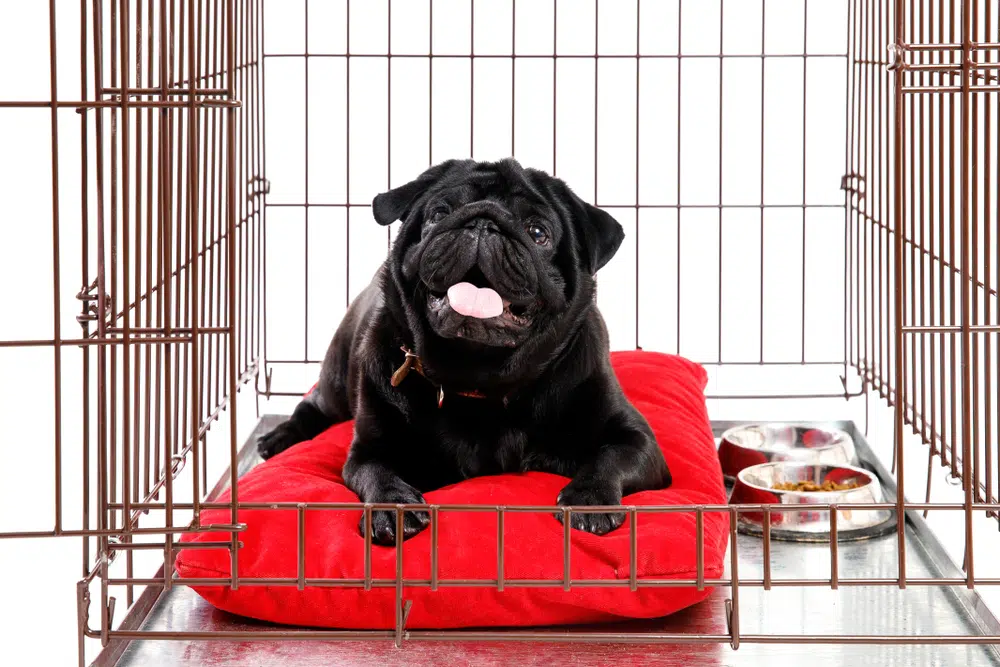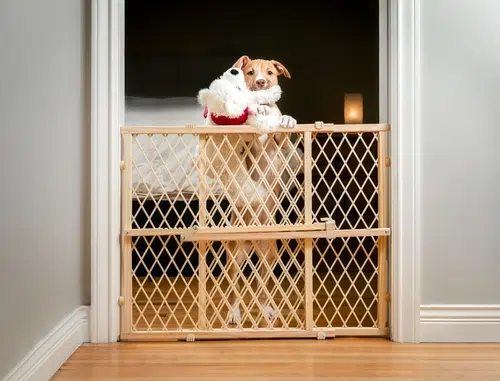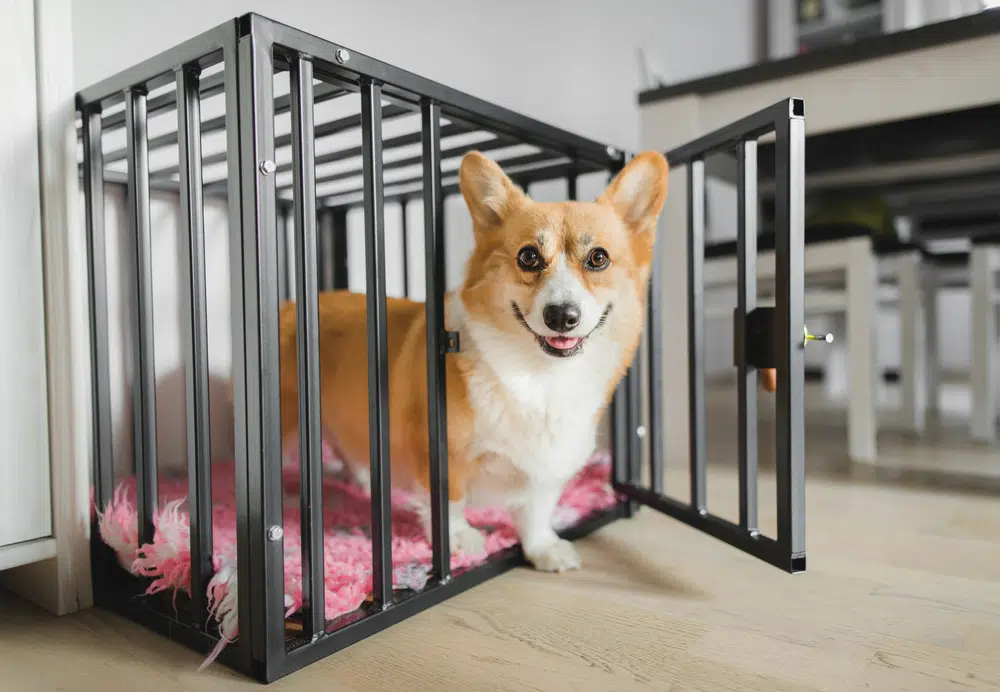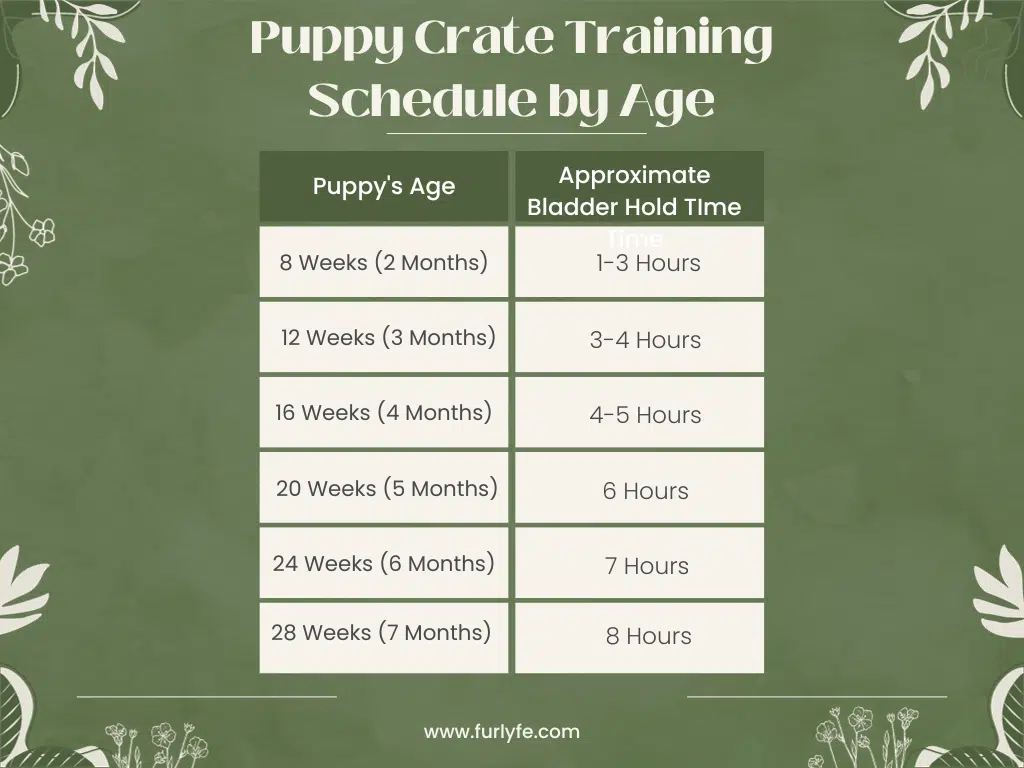Crate training has become a hot topic among dog owners and trainers, creating a passionate debate about its pros and cons. But how do you know if it’s the right choice for your furry friend, and how can you ensure the process is responsible and compassionate? In this definitive guide, we’ll explore the arguments for and against crate training, responsible techniques, common mistakes to avoid, and even alternatives to consider, so you can make an informed decision and answer the question, “is crate training cruel?” while creating a loving, safe environment for your canine companion.
Key Takeaways from this Blog:
- Crate training, when done responsibly with gradual introduction and positive reinforcement, can offer numerous benefits for both dogs and their owners.
- Choose the right crate size & type in an ideal location to create a safe & comfortable environment for your pet.
- Alternatives such as playpens or baby gates are available if crate training is not suitable – get expert advice to ensure your dog’s happiness & wellbeing!
Understanding the Crate Training Debate

Is Crate Training Cruel?
The crate training debate centers around the use of a crate to confine a dog, providing a safe and comfortable space for them. On one side, proponents argue that crate training can provide numerous benefits, such as aiding in-house training and preventing damage to household items. On the other hand, critics claim that crate training can be cruel and cause issues like anxiety and stress in dogs.
Despite these opposing views, many dog owners and trainers have found crate training success by following responsible crate training tips and techniques. However, it is crucial to understand both sides of the crate training debate to make an educated decision on what’s best for your dog’s life.
The Case Against Crate Training
One major concern among the critics of crate training is the potential for misuse, including using a crate that is too small for adult dogs, leading to discomfort and stress. Additionally, crate training can be detrimental to dogs with anxiety issues, particularly those with separation anxiety, exacerbating their psychological distress and negatively affecting their physical and mental health.
In examining the arguments against crate training, one must acknowledge that these concerns often arise from misuse or misunderstanding of the technique. With proper education and responsible practice, we can alleviate these potential problems, leading to a beneficial experience for our dogs.
The Case for Crate Training
When done correctly, crate training offers numerous advantages for both dogs and their owners. A properly crate-trained dog is likely to potty train faster, be less likely to damage items in the home, and be safer overall. This is not just potty training; it’s about creating a secure, comfortable space where your dog can retreat when needed, essentially tapping into a dog’s natural inclination as a den animal.
Crate training has several benefits for dogs, including:
- Making potty training easier
- Providing a safe and secure space for the dog
- Preventing destructive behavior when the dog is left alone
- Helping with separation anxiety
- Making traveling easier and safer for dogs
Ultimately, the case for crate training highlights the potential benefits when the process is approached with care, patience, and a focus on the dog’s wellbeing.
Responsible Crate Training Techniques
Following responsible crate training techniques can help you reap its benefits and avoid possible pitfalls, thereby ensuring your dog’s comfort and well-being. Learning how to crate train a puppy leads to a positive experience for both you and your pup, and crate training a dog can be a valuable tool in your pet care arsenal.
Gradual introduction, positive reinforcement, and monitoring the time spent in the crate are all crucial aspects of responsible crate training. By understanding and implementing these techniques, you can create a supportive environment that nurtures your dog’s growth and development, while also keeping them safe and secure.
Choosing the Right Crate and Location
Selecting the appropriate dog crate size and type is vital for your dog’s comfort and wellbeing. The right crate should be big enough for your pup to stand, turn around, and lie down comfortably, without being overly spacious. There are two main types of crates to choose from: hard plastic airline-style crates and wire crates. Both options can provide a safe and comfortable environment for your dog.
In addition to choosing the right crate, selecting the ideal location within your home is crucial. The crate should be placed in an area that’s both peaceful enough for your dog to relax but close enough to the household’s hustle and bustle, so they don’t feel isolated. This balance can help create a positive association with the crate and ensure your dog feels secure and content.
Gradual Introduction and Positive Reinforcement
Gradually introducing your dog to the crate is crucial for fostering a positive experience and minimizing stress and anxiety. Here are some steps to follow:
- Let your dog explore the crate with the door open.
- Entice them inside with treats or toys.
- Allow your dog to acclimatize to the crate at their own pace, never forcing them inside.
Using positive reinforcement during crate training is another vital aspect of creating a positive association with the crate. Rewarding your dog with treats, praise, and affection when they enter the crate willingly can help reinforce their good behavior and encourage them to see the crate as a safe, comfortable space.
Monitoring Time Spent in the Crate
To ensure your dog’s well-being, it’s essential to monitor the time they spend in the crate and provide regular breaks. A useful rule to remember is that puppies can usually wait for as long as they are months old plus one hour between bathroom breaks. This is important when it comes to the potty training process. However, the maximum recommended time a dog should spend in a crate in one stretch is typically around 4-8 hours, depending on the dog’s age and needs. The below table provides guidelines for when your pup might need a potty break.
By keeping track of your dog’s time in the crate, you can prevent potential issues like anxiety, stress, and discomfort. Regular breaks for potty trips, exercise, and socialization can help create a balanced and healthy lifestyle for your dog, ensuring their happiness and well-being.
Common Mistakes and How to Avoid Them
Although crate training can be an effective tool for managing your dog’s behavior and safety, it does have potential drawbacks. Mistakes commonly associated with crate training include using it as a form of punishment, rushing the process, and disregarding indications of distress in your dog.
By recognizing and addressing these mistakes, you can create a successful, stress-free crate training experience for both you and your dog. Learning from experienced dog trainers and owners can help you navigate these potential challenges and make informed decisions for your pet’s well-being.
Using the Crate as Punishment

Is Crate Training Cruel?
Using the dog’s crate as punishment is counterproductive and can lead to negative associations, stress, and fear in dogs. Instead, the crate should be a safe and comfortable space where your dog can retreat when needed. Crates should be used as a management tool, not as a form of punishment.
To create a positive crate training experience, focus on reinforcing good behavior with treats, praise, and affection. This approach not only encourages your dog to see the crate as a safe space but also helps address any underlying behavioral issues effectively.
Rushing the Crate Training Process
Patience and gradual progression are key when introducing your dog to the crate. Rushing the crate training process can cause stress, anxiety, and negative associations with the crate. Instead, take your time, allowing your dog to become comfortable with the crate at their own pace and using positive reinforcement to create a positive association.
By approaching crate training with patience and understanding, you can create a supportive environment that nurtures your dog’s growth and development, while also keeping them safe and secure. Learning how to crate train your dog is an essential part of this process.
Ignoring Signs of Distress
During crate training, it’s important to recognize and address any signs of distress your dog may exhibit, such as:
- Excessive barking
- Whining
- Pacing
- Trying to escape from the crate
Ignoring these signs can lead to increased anxiety and stress, which can negatively impact your dog’s overall well-being.
To address signs of distress, remain calm and patient, and consider seeking professional help from a dog trainer or veterinarian if necessary. By addressing your dog’s needs and concerns, you can ensure a positive and comfortable crate training experience.
Meet: Rhodesian Ridgeback
Alternatives to Crate Training

Is Crate Training Cruel?
Although crate training proves effective for many dogs, it’s important to acknowledge that it may not suit every dog or household. If you’re considering alternatives to crate training, there are other methods for managing your dog’s behavior and keeping them safe without relying on a crate.
Exploring alternatives like playpens, baby gates, and dog-proofing your home can provide a safe, confined space for your dog without the need for a crate. By considering different options, you can find the best solution for your dog’s specific needs and preferences.
Playpens and Baby Gates
Playpens and baby gates offer a great alternative to crate training, providing a safe and secure area for your dog to play and rest in while still allowing them to interact with the family. These barriers can be easily set up throughout your home, allowing you to create a customized space tailored to your dog’s needs and your living situation. In times when you’re not at home, dog sitters can also be a helpful solution to ensure your pet’s well-being.
When choosing a playpen or baby gate, consider factors such as size, material, and accessibility to ensure your dog’s safety and comfort. By providing a secure, confined space without a crate, you can still manage your dog’s behavior effectively while giving them more freedom to move and interact with their environment.
Dog-Proofing Your Home

Is Crate Training Cruel?
Dog-proofing your home is another alternative to crate training that can help keep your dog safe and prevent accidents or damage to household items. To dog-proof your home, you can:
- Store items like cleaning supplies, medications, and small objects that could be swallowed in a secure place
- Provide your dog with stimulating toys
- Ensure they get enough exercise
By taking these steps, you can create a safe and enjoyable environment for your dog, support responsible dog breeders, and collaborate with professional dog walkers to effectively train dogs.
By creating a safe environment for your dog, you can minimize the risk of accidents and damage while allowing your dog to roam freely and comfortably in your home. Dog-proofing your home not only keeps your dog safe but also helps them feel more at ease and secure in their surroundings.
Expert Opinions and Testimonials
Insights and advice from professional dog trainers, veterinarians, and seasoned dog owners can be invaluable when it comes to crate training. The consensus among most experts is that crate training is beneficial and effective in housebreaking puppies and fostering desirable behaviors in dogs. However, they also recognize that extended confinement can have negative psychological effects on dogs, leading to aggression and withdrawal.
By learning from expert opinions and testimonials, you can make an informed decision on whether crate training is the right choice for your dog. Ultimately, the decision should be based on your dog’s specific needs, temperament, and living situation, ensuring their happiness and well-being.
Summary for Is Crate Training Cruel?
In conclusion, crate training can be a valuable tool for managing your dog’s behavior and keeping them safe when done responsibly and compassionately. By understanding the crate training debate, implementing responsible techniques, and avoiding common mistakes, you can create a safe and comfortable experience for your dog. However, it’s important to recognize that crate training may not be the best option for every dog or household, and alternatives like playpens, baby gates, and dog-proofing your home are worth exploring. Ultimately, the key to success lies in understanding your dog’s unique needs and preferences, and making an informed decision that ensures their happiness and well-being.
Frequently Asked Questions
1. Is it ethical to crate train a dog?
Crate training a dog can be a positive experience for them, as long as it is done with gentle leadership and positive conditioning. If used as a form of punishment, however, it is not ethical.
2. How long does it take for a dog to get used to crate training?
Crate training your pup can take days or weeks, depending on their age and temperament. It’s important to make sure the cage is a positive experience and that you take the process slowly.
3. What is crate training?
Crate training is a great way to give your dog a safe and comfortable space, while also providing them with a sense of security. It involves confining them in a crate to create a positive environment.
4. Is crate training suitable for all dogs?
Crate training can be beneficial for many dogs, but it’s important to consider the individual needs, temperament, and living situation of your pet before deciding if it is suitable.
5. What are some potential hazards of crate training?
Crate training can be risky if done incorrectly, as it can lead to using the crate as punishment, moving too quickly, or not paying attention to signs of discomfort.
Interesting Reads:
Blue Buffalo vs Diamond Naturals – Choosing the Right Pet Food











Get involved!
Comments